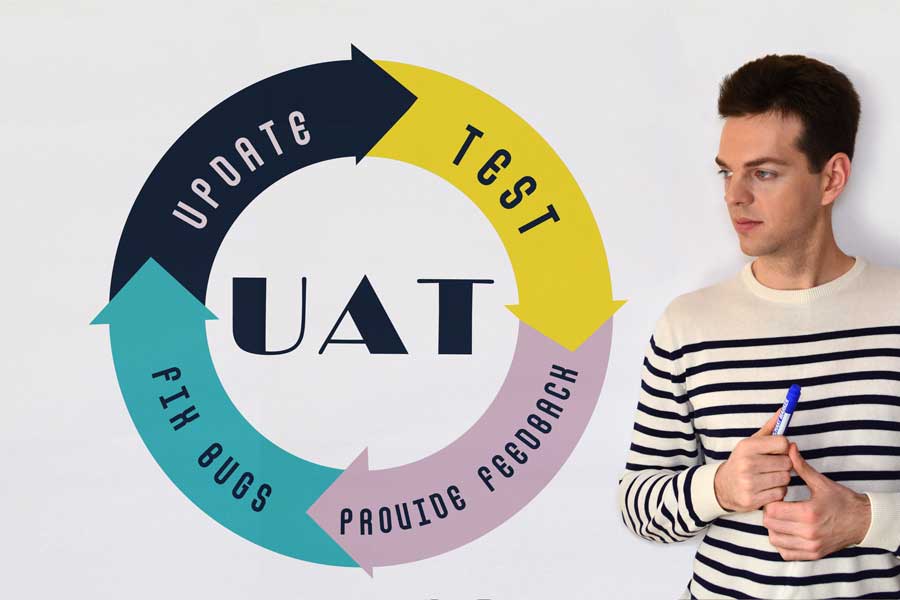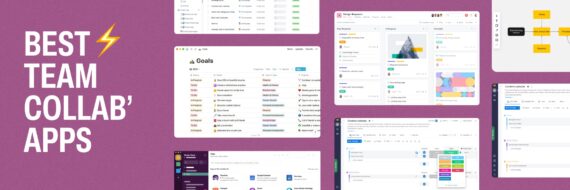What is User Acceptance Testing (UAT)?
User Acceptance Testing (UAT), otherwise known as Application, Beta, or End-User Testing, is a stage in the software development process that is performed by the end-user, after functional testing, integration testing, regression testing, and system testing is done. It’s the last phase of the software testing process. Throughout the software development life cycle (SDLC), the product undergoes various types of testing by the testing team and developers.
UAT is a testing activity to verify that the developed product is working properly and the implemented functionalities are easy to find, a step you shouldn’t overlook when launching a minimum viable product. It is not only the usability of the product that is being tested at this stage but also the software itself; actual software users test the product to ensure it can handle required tasks in real-world scenarios, according to specifications and provide the best user experience.

Tests are performed at various stages of the project, depending on the challenges faced by the company, the degree of project advancement, and the specification of the interactive product that is being created. There are many types of software tests that fall under the definition of User Acceptance Testing. The most popular are:
- Beta testing – software is being tested by the end-users; they use the software as intended and provide feedback with an aim of meeting user acceptance criteria.
- Black box testing – also known as behavioral testing, analyzes the functionality of a software/application without knowing much about the internal structure/design of the item that is being tested.
- Operational Acceptance Testing – used to conduct operational readiness (pre-release) of a product.
- Contract Acceptance Testing – software is tested based on specific criteria defined as a “contract” between the developer and the client.
- Regulation Acceptance Testing – legal regulations are checked against the software.
All it usually takes to find about 80% of the problems with your product is to test it with only 5 users. Many companies that avoid testing at first, eventually realize that the honest feedback from their target audience is worth its weight in gold. Testing the usability and performance of digital products is crucial to understanding the end-user, estimating the business value of the project, and determining what should be improved to increase results. User Acceptance Testing is not only performed on new apps and websites; If you are introducing major changes to the product, it allows you to check whether the proposed alterations will be well received and achieve the planned effect through usage of the product by the end-user. What’s more, it can also help determine what is missing from the offer and which direction to take next. UAT is an excellent tool for detecting errors and problems in products that meet general design and UX standards.
🎬 Learn what Slickplan can do!
We filmed a short video to show you exactly how to use Slickplan
How User Acceptance Testing (UAT) is used?
Traditionally, in waterfall methodologies, UAT doesn’t occur until later stages of the product design, close to the delivery date. In most cases this is not a good idea, as you may find yourself in a situation where you’ve waited so long only to realize that the requested functionality was misunderstood by the software development team. By that time, you’ve already spent a lot of money to build it and now you need to spend more to fix it. This usually comes with a higher risk and lower quality of the end product. That’s why in Agile teams UAT occurs earlier and more often. If you include the testing in the process planning, you can schedule it across the life of the project. This doesn’t need to be difficult or time-consuming.

There are a couple of conditions that need to be met before successful UAT can happen. First of all, you need to know what the business requirements are. This is a very important step, as it allows you to identify and develop test scenarios. For this purpose, you can use flow diagrams, business use cases, system requirement specifications, and other documents created during the design process. Additionally, the application code should be fully developed at this point and all defects other than those that are “cosmetic” should be fixed. Once these conditions are met, you can start working on the UAT test Plan. It should specify the following:
- the list of processes that need to be tested,
- test scenarios,
- guidelines for which data to use – it is best advised to use live data for UAT, though it should be scrambled for privacy and security,
- entry & exit criteria – in other words, what needs to be done before the testing begins and how you will know when to stop; entry criteria could be that the scenarios and test cases are reviewed and approved by key stakeholders; exit criteria to move the product into release could be that all of the test cases have been executed and 100% of all critical and high defects have been fixed,
- timeline,
- the UAT team responsible for testing – functional experts and business users are both needed for UAT.
It’s time to assemble the team. UAT teams gather and analyze qualitative feedback from testers. The core team for UAT testing should include a business representative (Product Owner, etc.), Technical Project Manager, and a Quality Assurance representative. It is also good to have a developer and network admin close-by, ready to fix anything that goes wrong (e.g. your testing environment shuts down, or there are errors preventing users from testing). Reviewers should be assigned to analyze testing results to determine if end-user criteria has been met. Your “dream team” depends heavily on who the stakeholders are and the specifics of the product, so include anyone you feel is important.
Recruit your testers
Once you’ve prepared a rock-solid plan and gathered your testing team, it’s time to recruit the actual users who will be doing the testing. Testers can be recruited from your existing user base. Your sales team might be helpful to find the right users for your needs. It is also quite common to delegate the testing job to the specialist UAT testers. The thing to remember in such cases is that these professionals are not your real users, they don’t always understand the product well enough and so don’t have the same expectations or needs as the real end-users.
Most often the whole testing process can be done online, which means you won’t have to supply your testers with the hardware. More complex or confidential testing projects may require gathering a dedicated team of user testers at your office.
Think visually. Improve UX with Slickplan
Build intuitive user flows, stronger customer journeys and improve information architecture.
UAT tools
In order to make your UAT as easy and efficient as possible, it is important to choose the right tool for the job. Copying and pasting screenshots into Word or Excel is time-consuming and doesn’t provide developers with much information.
The right tool will allow you to document tests using screen recording, commenting on screenshots and synchronizing the list of defects with the project management tool of your choice. It can significantly reduce the back and forth between the developers’ team and testers. There are many testing tools available on the market.
Usersnap is a popular platform for providing visual feedback on the tested software/ web-based applications. It allows users to mark the bugs right on the screen, leave comments and suggestions, and share feedback. You can also try Zephyr, PractiTest, or Jira for this purpose. What is important is to find out which tool is the best for your project. Check out this list of testing tools for more information.
Try Slickplan’s Diagram Maker to create user flows, journey paths and other types of diagrams before you design!
The last part of UAT is a thorough analysis and responding to the bugs found by the testing team. It’s time to make final adjustments to the code so that the software is bug free.
After bugs and errors are fixed, you can repeat the testing phase to ensure that all the issues were properly addressed. Then it’s time for the testing team to indicate acceptance of the software application. It means that the product meets user requirements and is ready to be rolled out in the market.






 X
X

